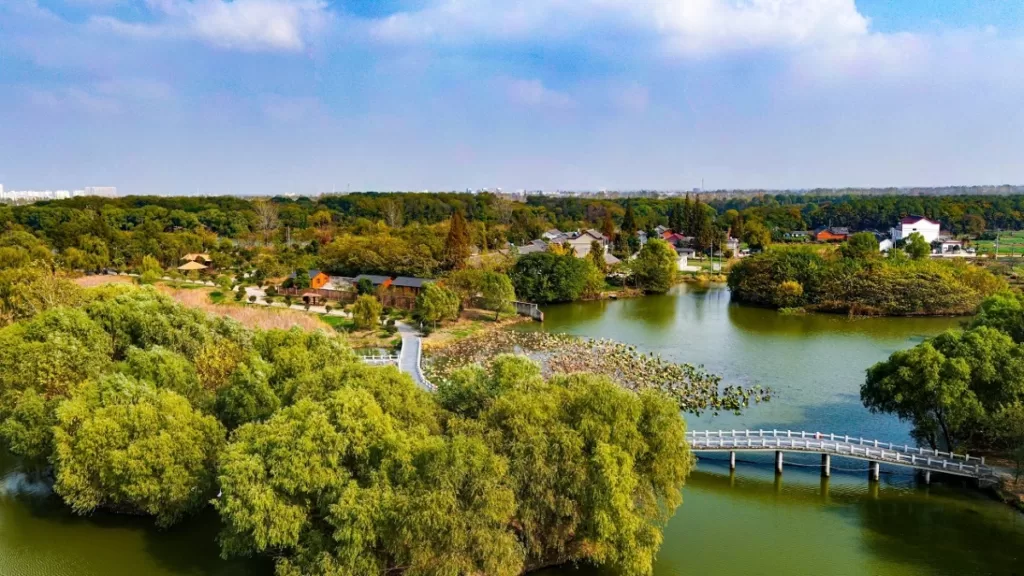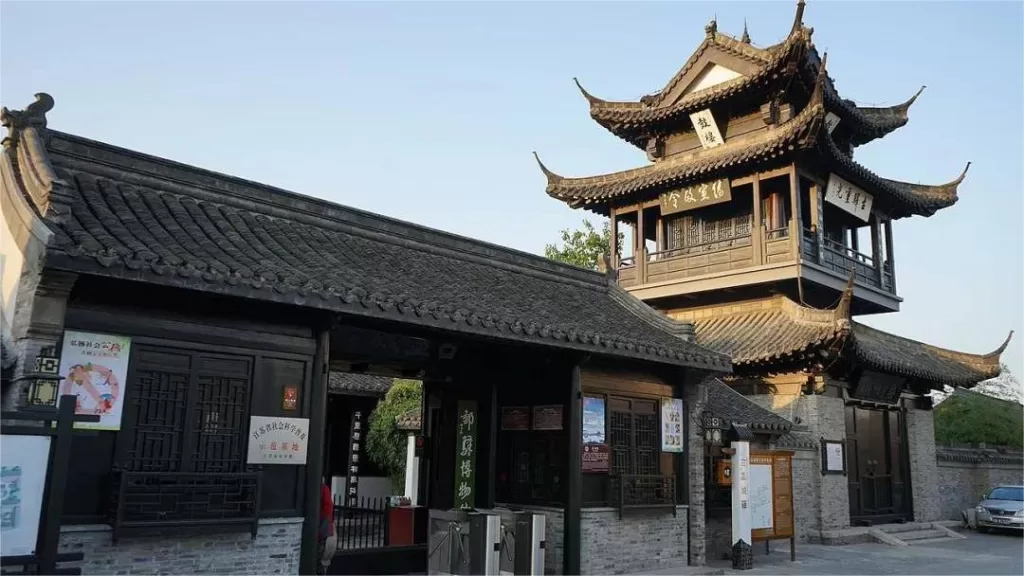Zhenguo Temple (镇国寺), situated on the heart of an island within the Grand Canal in Gaoyou, Yangzhou, is a remarkable place that holds great historical and cultural significance. It is an essential part of the Grand Canal, China’s 46th UNESCO World Heritage Site, and is often referred to as the “Buddhist City of the Grand Canal.”
The roots of Zhenguo Temple trace back to the year 874 during the Tang Dynasty. It all began when the younger brother of Emperor Yizong, chose to renounce the worldly life and embarked on a journey to visit renowned Buddhist sites. One day, he arrived in Gaoyou, by the tranquil waters of the Grand Canal, surrounded by the majestic Zhuhu Lake. Overwhelmed by the beauty of the natural surroundings and in an effort to transcend worldly desires, he decided to stay, build a thatched hut, and begin his meditation practice. Following his passing, his remains were enshrined in the hut, and with imperial support from Emperor Xizong, the temple was officially established and named “Zhenguo ZenTemple,” with a white pagoda erected to house the monk’s relics. Despite facing the test of time and the ever-changing circumstances, the temple’s physical structures have largely disappeared, leaving only the distinctive white pagoda as a testament to its historical significance.
Basic Information
| Estimated Length of Tour | 1 hour |
| Ticket Price | Free |
| Opening Hours | 6.00 – 17.00 |
| Telephone Number | 0086-0514-84583827 |
Location and Transportation
Zhenguo Temple is located in the heart of the Jiangsu Province, within the jurisdiction of Gaoyou City. It occupies a central position along the Beijing-Hangzhou Grand Canal, which is one of China’s most historic and significant waterways. To the east, the temple faces the urban area of Gaoyou City, while to the west, it enjoys proximity to the scenic Gaoyou Lake.
Tourists can take bus Gaoyou 15 or Gaoyou 5, get off at Huijin Gongguan Stop (汇金公馆站, Huijin Mansion Stop), and walk about 100 meters to the south to reach the temple.
Zhenguo Temple Pagoda
The Zhenguo Temple Pagoda, also known as the West Pagoda, is often referred to as the “Southern Giant Wild Goose Pagoda,” and it’s acclaimed as a precious gem along the Grand Canal. This seven-story square brick pagoda stands at an impressive height of 35.36 meters, and it features a bronze spire in the shape of a two-meter-high gourd, inscribed with the words “May the winds be favorable, and the nation and people be prosperous (风调雨顺,国泰民安).”
Despite several renovations over the years, the pagoda retains the architectural characteristics of the Tang Dynasty, exuding the grace and style of that era. In 1956, during the widening of the Grand Canal, the waterway was redirected to preserve the pagoda, transforming it into a brilliant jewel on the Grand Canal’s landscape.
Today, Zhenguo Temple and its pagoda have been restored, making it a splendid attraction for visitors who wish to explore the rich history and cultural heritage of this unique island on the Grand Canal. Its serene environment and timeless architecture make it a place of spiritual reflection and historical exploration, connecting modern-day travelers with a bygone era of devotion and craftsmanship. Zhenguo Temple stands as a testament to China’s cultural legacy, embracing both the tranquility of Buddhist spirituality and the grandeur of ancient architecture.
Vlog about Zhenguo Temple
Useful Tips Summarized from Reviews
No Need for Reservation: Even during peak hours, there is no need for advance reservations, and the number of visitors is very low. This allows for a more relaxed and peaceful exploration of the temple.
Scenic Walk Along Hubin Road: After touring the temple, take a leisurely walk along Hubi Road to enjoy the picturesque scenery of Gaoyou Lake. This can be a serene way to extend your visit and appreciate the beauty of the surroundings.
Vegetarian Meal Option: If you time your visit around lunch or dinner, consider going to the monastery’s dining area and ordering a vegetarian meal (斋饭). This is a cultural and culinary experience that adds to the overall visit.
Observing Temple Life with Bunnies: Zhenguo Temple is known for having many small rabbits. You’ll find them either resting inside the halls or nibbling on the grass in the courtyard. This adds a charming and lively touch to the temple atmosphere.
Spiritual Activities Based on Time of Day: Consider participating in the temple’s spiritual activities. In the morning, it’s suggested to pray for peace, while in the afternoon, visitors may seek blessings for prosperity and good fortune.









The rabbits at Zhen Guo Temple are so fat and big!
Zhenguo Temple is very quiet and not crowded. There are a few people burning incense and some volunteers (probably). In the backyard, there are two pretty rabbits that are quite cute.
Walking along Gaoyou Lake to the bridge is quite suitable for a stroll.